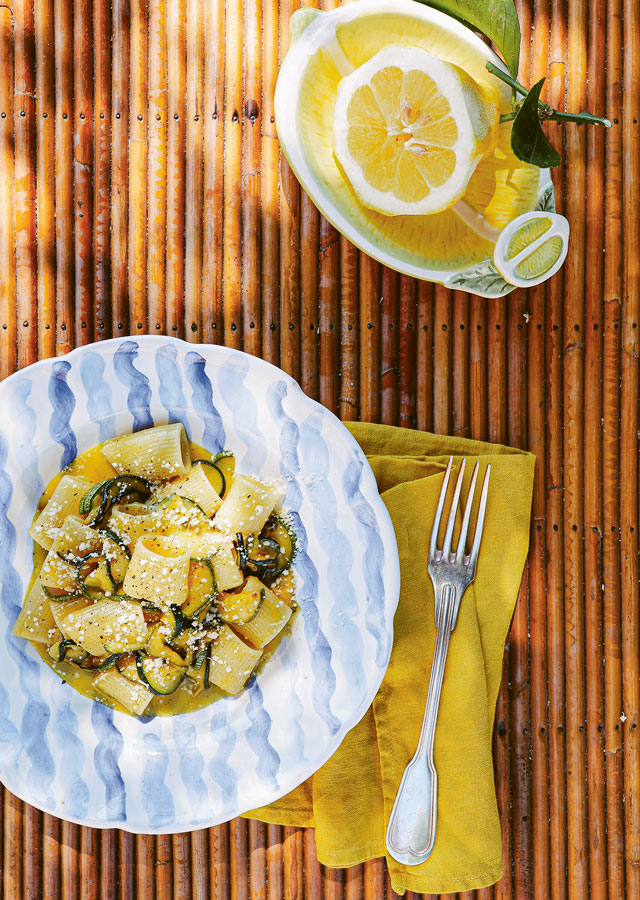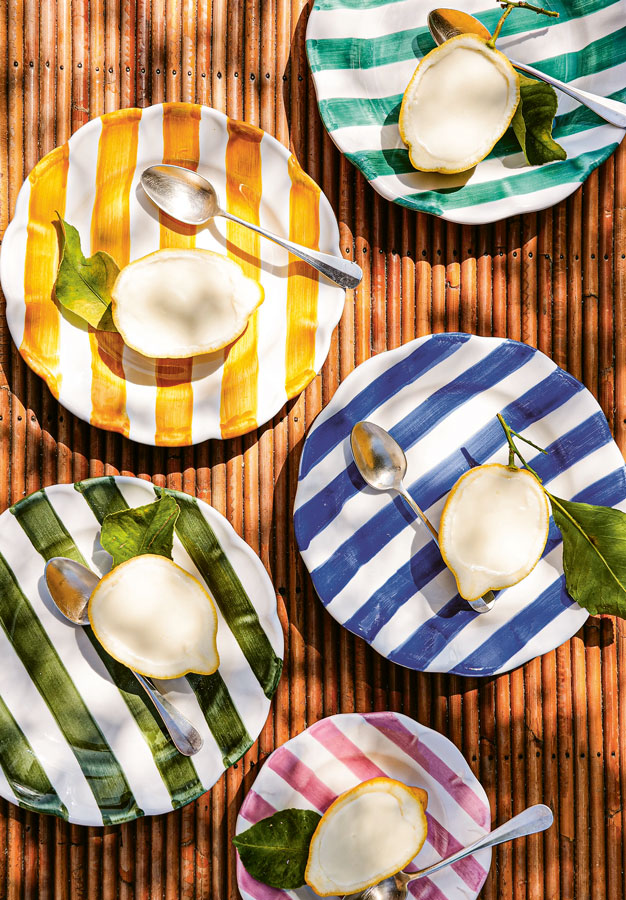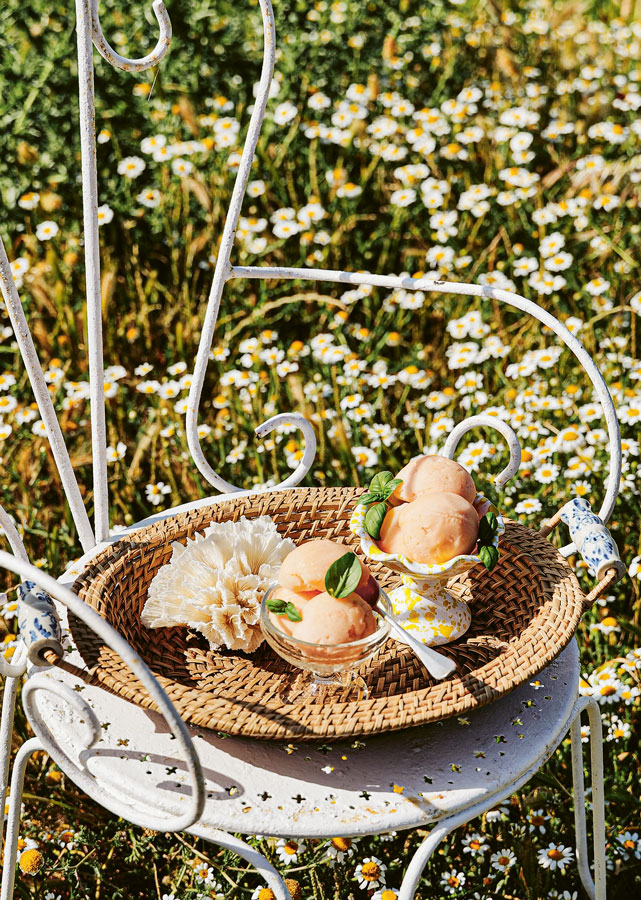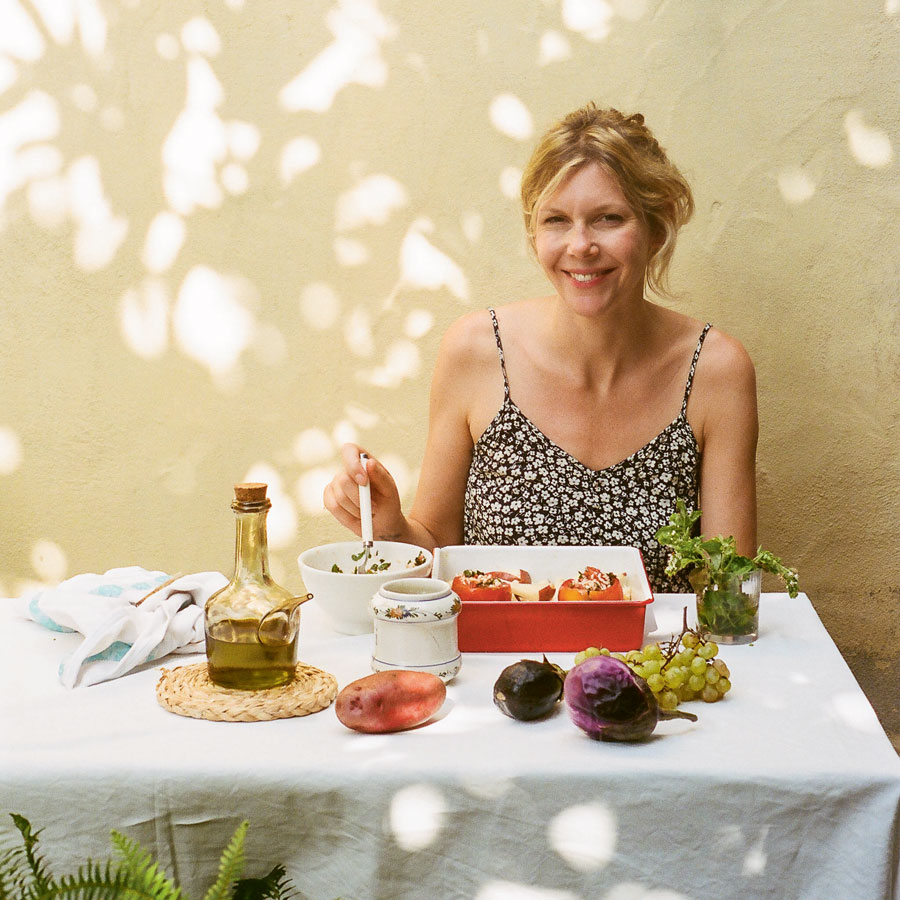The Sardinia-based food writer Letitia Clark is passionate about lemons, as revealed in these Italian-inspired recipes for lemon carbonara, possets and sorbet …
“The very first lemon I fell in love with was made of plastic. It sported a perfect teat at one end, a tiny, click-shut lid at the other and was dotted all over with perfect dimples. It lived on the top shelf of my grandmother’s refrigerator and came out for special occasions, or more precisely, prawn cocktail and pancakes,” so says Letitia Clark in her new book For the Love of Lemons, which celebrates the versatility of this much-loved citrus fruit used in recipes for crisp salads, delicious pasta dishes and indulgent desserts.
Clark shares three recipes exclusively with THE GLOSS, perfect for summer entertaining … @letitia_ann_clark

LEMON AND COURGETTE CARBONARA
When I talk about a dish as a “carbonara”, I mean the method of creating a creamy pasta sauce with eggs that are cooked just enough to emulsify and thicken but not so much as to become scrambled or solid. I prefer carbonara sauces made without the traditional pancetta/guanciale, as I find the classic version of the dish quite heavy, so I instead like to use vegetables. Artichokes, peas, broad (fava) beans and braised greens all make delicious carbonaras, as do courgettes (zucchini).
This courgette carbonara is lifted by a hefty hit of lemon (both zest and juice), which cuts through the richness of the eggs beautifully. It is also essential to counteract the sweetness of the braised courgettes, which become almost jammy after slow sautéing in plentiful olive oil and garlic. Courgette and lemon is a combination you will often see in my recipes, and it is a happy and mutually complementary marriage; the sweetness of the vegetable is cut by the acidity of the fruit, and the innate lemony-ness of courgettes accentuated by both the zest and juice of the citrus.
Choose small, young courgettes if you can find them, their flavour is superior and they have a lower water content. I also use pecorino sardo, which has both a lemony flavour and nutty sweetness that work perfectly here. If you can’t find it, use Parmesan or a mix of pecorino romano and Parmesan. I often make the sautéed courgettes the night before, and keep them in the refrigerator before putting this together the next day for a last-minute lunch. I like using smooth penne, but spaghetti or rigatoni also work well.
Serves 2
Ingredients
4 tbsp extra virgin olive oil, plus extra to serve
1 garlic clove, bashed
2 medium or 3 small courgettes, sliced in half lengthways, then into half-moons
Sea salt
180g (61/2 oz) pasta of your choice
1 egg and 2 egg yolks
4 tbsp grated pecorino (or Parmesan)
Zest of 1 small lemon and juice of 1/2
Basil leaves, to serve
Method
1. Heat the oil in a frying pan (skillet) over a medium-low heat, then fry the garlic clove until it just begins to sizzle and smell good. Add the courgette slices and sauté, stirring regularly, until they are golden all over, beginning to break down and almost jammy. Season well with salt and set aside (or leave to cool, then keep in the refrigerator for future use).
2. Cook the pasta according to the packet instructions in a large pan of well-salted boiling water until al dente.
3. Meanwhile, mix the egg and egg yolks, cheese and lemon into the courgette mixture, and begin to heat very gently, stirring all the time.
4. Scoop out the pasta with a slotted spoon straight into the courgette pan along with a splash or two of the cooking water. Stir and toss over a low heat until you have a creamy sauce that coats the pasta.
5. Taste for seasoning, add a few fresh basil leaves, extra Parmesan and a drizzle of your best oil, then serve.
Variation: Artichoke Carbonara
Make as above for courgette carbonara, but in place of the courgettes, use 4-5 prepared, sliced artichoke hearts and finish with chopped mint rather than basil.

LEMON POSSETS IN LEMON BOATS
When you are lucky enough to have beautiful, leafy lemons, there is no nicer thing than halving them, scooping out the flesh (to squeeze) and filling them with lemon posset. The flavour of the rind perfumes the posset and provides a perfect picturesque vessel. You will need to scoop out four whole lemons, to create the “boats” this is served in, but you only use the juice of two, so the pulp from the others can be used in another recipe.
Serves 8
Ingredients
90 ml (3 fl oz/generous 1/3 cup) lemon juice (I use 2 large lemons)
400 ml (14 fl oz/generous 11/2 cups) double (heavy) cream
90 g (3 oz/1/2 cup minus 1 tbsp) sugar
8 hollowed-out lemon halves, to serve
Method
1. Combine the cream and sugar in a saucepan and bring to a low boil. Stir gently (the cream will expand a lot) and continue to cook for a minute or two, making sure the sugar has dissolved.
2. Remove from the heat, and allow to cool for a few minutes.
3. Add the lemon juice to the cream mixture, then decant into your lemon boats. (Note: the boats need to be on a flat surface so the liquid doesn’t spill.)
4. Chill in the refrigerator for at least 2 hours, or overnight.

MELON, LEMON AND BASIL SORBET
The delicate, almost ethereal sweetness of melon works beautifully when sharpened by plentiful fresh lemon juice and enhanced by fragrant basil. Playing on the peppery basil of this sorbet, I like to serve it with a drizzle of my most fragrant olive oil. It’s Mediterranean summer in a mouthful.
Serves 6
Ingredients
200 ml (7 fl oz/scant 1 cup) water
150 g (51/2 oz/3/4 cup) sugar
A few basil leaves, torn, plus extra to serve
1 medium melon (I like Cantaloupe)
Juice of 4 lemons
A little extra virgin olive oil, to serve
Method
1. Combine the water and sugar in a saucepan and bring to the boil, then reduce the heat and simmer for a few minutes until you have a simple sugar syrup. Remove from the heat and leave to cool.
2. Add the torn basil leaves, stir and leave to infuse at room temperature for at least 20 minutes.
3. Cut the melon into chunks, remove the peel and discard the seeds. Blitz the melon flesh with the syrup and then strain through a sieve (fine-mesh strainer). Add the lemon juice, tasting as you go to check the sweetness.
4. Churn in an ice-cream maker according to the manufacturer’s instructions or freeze in a shallow tray as a granita, raking it with a fork every so often as it freezes. Serve decorated with a few basil leaves.

For the Love of Lemons, Letitia Clark, Quadrille, €34. Photography by Charlotte Bland.
We may earn a commission if you buy through affiliate links on our site.






